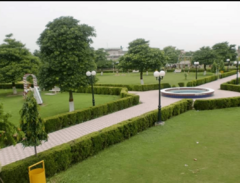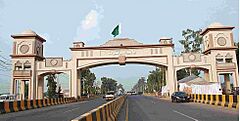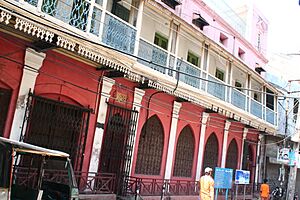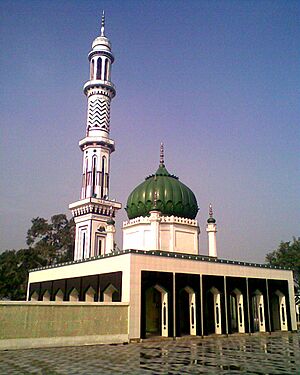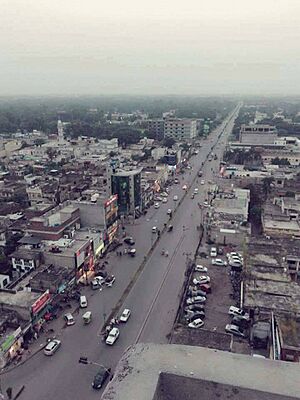Sialkot facts for kids
Quick facts for kids
Sialkot
سیالکوٹ
|
||
|---|---|---|
|
Clockwise from the top:
Clock Tower, Fatima Jinnah Park, Sialkot Gate, Sialkot International Airport |
||
|
||
| Nicknames:
City of Iqbal
|
||
|
Location in Punjab, Pakistan
|
||
| Country | ||
| Province | ||
| Division | Gujranwala | |
| District | Sialkot | |
| Government | ||
| • Type | Municipal Corporation | |
| Area | ||
| • City | 135 km2 (52 sq mi) | |
| Population
(2023)
|
||
| • City | 835,337 | |
| • Rank | 13th, Pakistan | |
| • Density | 6,188/km2 (16,030/sq mi) | |
| Demonym(s) | Sialkoti | |
| Time zone | UTC+5 (PST) | |
| Postal code |
51310
|
|
| Calling code | 052 | |
| Old name | Sagala or Sakala | |
| Website | Municipal Corporation Sialkot | |
Sialkot (pronounced See-al-kot) is a lively city in Punjab, Pakistan. It's the main city of the Sialkot District and the 13th largest city in Pakistan by population. Sialkot is surrounded by Jammu to the northeast, Narowal to the southeast, Gujranwala to the southwest, and Gujrat to the northwest.
This city is thought to be the ancient city of Sagala. Sagala was the capital of the Madra Kingdom and was destroyed by Alexander the Great way back in 326 BCE. Later, in the 2nd century BCE, it became the capital of the Indo-Greek kingdom under Menander I. During this time, Sialkot became a very important center for trade and Buddhist ideas.
Sialkot is famous for its business spirit. It's known as a "world-class manufacturing hub." In 2017, Sialkot exported about $2.5 billion worth of goods. This was about 10% of all of Pakistan's exports!
The city is often called the Football manufacturing capital of the World. This is because it makes over 70% of all footballs used globally. Sialkot is also home to the Sialkot International Airport, which was Pakistan's first airport owned by private companies. Sialkot, along with nearby Gujranwala and Gujrat, forms a special area called the "Golden Triangle." These cities are known for their strong export businesses.
Contents
- Exploring Sialkot's Past
- Sialkot's Climate and City Layout
- People and Religions in Sialkot
- Sialkot's Economy: A Hub of Production
- Getting Around Sialkot
- Famous People from Sialkot
- Awards and Recognition
- Sister Cities
- Images for kids
- See also
Exploring Sialkot's Past
Sialkot has a very long and interesting history, going back thousands of years.
Ancient Times: The City's Beginnings
Founding of Sagala: A Kingdom's Capital
Sialkot is believed to be the ancient city of Sagala. This city was the capital of the Madra Kingdom. It's mentioned in the Mahabharata, a very old Indian story. Some people think the city might have been home to the Saka people, who were Scythians from Central Asia. Sagala was located between the Chenab and Ravi rivers.
Greek Influence: Alexander's Visit
The Roman-Greek historian Arrian wrote in his book Anabasis of Alexander that Alexander the Great captured ancient Sialkot, which he called Sagala. The city had about 80,000 people before Alexander's invasion. It was destroyed to warn other cities not to fight against him.
Indo-Greek Era: A Center of Trade and Ideas
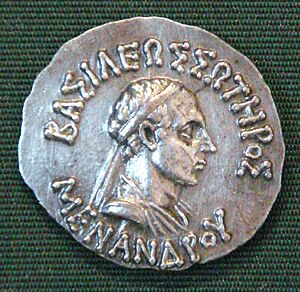
After being destroyed, the ancient city was rebuilt. It became the capital for the Indo-Greek king Menander I in the 2nd century BCE. The new city was built a little away from the old one.
Under King Menander, Sialkot became a very successful trading center, especially known for its silk. Menander became a Buddhist in Sagala after talking with the Buddhist monk Nagasena. This story is told in the Buddhist book Milinda Panha. This book describes Sialkot as a rich trading city with many green spaces. After Menander became a Buddhist, Sialkot became an important place for Buddhist ideas.
Later Ancient Periods: Huns and Travelers
Around 460 CE, the Alchon Huns from Central Asia took over the region. Sialkot became an important center for them around 515 CE. The Chinese traveler Xuanzang visited the city in 633 CE. He noted that the city had been rebuilt about 2.5 miles away from the ruins left by Alexander the Great. During this time, Sialkot was a key political center in North Punjab.
Medieval Times: Changes and New Rulers
Around the year 1000, Sialkot became less important as the nearby city of Lahore grew. However, after Lahore was taken by the Ghaznavid Empire in the early 11th century, the capital of the Hindu Shahi empire moved to Sialkot.
Sialkot became part of the Sultanate of Delhi after Muhammad Ghauri conquered Punjab in 1185. Ghauri thought Sialkot was important enough to have soldiers stationed there. He also fixed the Sialkot Fort.
In the 1200s, Imam Ali-ul-Haq, a respected Sufi saint, came to Sialkot from Arabia. He helped many people in the region become Muslims, making Sialkot a mostly Muslim city. He later died in battle and is remembered as a hero.
Sialkot became the capital of the Punjabi ruler Jasrat's kingdom in the early 1400s. Jasrat took over most of Punjab from the Delhi sultanate. This was a very good time for Sialkot. Later, the Mughal emperor Babur captured Sialkot in 1520.
Pre-Modern Era: Mughal and Sikh Rule
Mughal Empire: Growth and Craftsmanship
During the early Mughal period, Sialkot was part of the Lahore province. It is said that Guru Nanak, who started Sikhism, visited the city in the early 1500s.
During the rule of Emperor Akbar, Sialkot's area was given to Raja Man Singh. He fixed the city's fort and worked to make the population and economy grow. Paper-makers from Kashmir moved to Sialkot during Akbar's time. Sialkot became famous for its special Mughal Hariri paper, known for being very white and strong. The city's metalworkers also made many weapons for the Mughal rulers.
Under later Mughal emperors like Jahangir and Shah Jahan, Sialkot continued to grow and prosper. Many beautiful houses and gardens were built. During Aurangzeb's reign, Sialkot became a major center for Islamic learning and attracted many scholars.
After the Mughals: New Powers
After the Mughal Empire weakened around 1707, Sialkot had to defend itself. In 1739, Nader Shah of Persia captured the city during his invasion. Later, Sialkot came under the control of powerful Pashtun families.
Sikh Empire: Ranjit Singh's Rule
Sikh leaders took control of the Sialkot region by 1786. The city was divided into four parts, and its leaders invited people who had left to come back. The Sikh Empire of Ranjit Singh captured Sialkot in 1808. Sikh forces then controlled Sialkot until the British arrived in 1849.
Modern Times: British Era and Independence
British Rule: A New Era of Industry
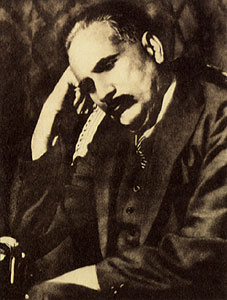
The British took over Sialkot and all of Punjab after defeating the Sikhs in 1849. During the British era, Sialkot began to become very successful. The city was already known for making paper and iron. In the 1890s, it became a center for metalwork. By the 1920s, surgical instruments were made in Sialkot and used all over British India. The city also started making sports goods for British soldiers because there were timber reserves nearby.
In 1877, the famous poet Allama Iqbal, who inspired the idea of Pakistan, was born in Sialkot.
By the end of World War II, Sialkot was considered the second most industrial city in British Punjab, after Amritsar. Much of the city's growth was paid for by local taxes. Sialkot was one of the few cities in British India to have its own electric company.
Partition of India: A Time of Change
In 1946, there were some conflicts between different religious groups in Sialkot. When India was divided in 1947, many Hindu and Sikh people left Sialkot for India. At the same time, many Muslim refugees from India came to settle in Sialkot.
After Independence: Rebuilding and Resilience
After Pakistan became independent in 1947, Sialkot faced big challenges. About 80% of its industries were destroyed or abandoned. However, the city's economy bounced back. The government helped rebuild, and local business people stepped up. By the 1960s, new roads were built to connect Sialkot to other parts of Pakistan.
During the Indo-Pakistani War of 1965, the Indian Army attacked the Sialkot area. The Pakistan Army successfully defended the city, and the people of Sialkot strongly supported their troops. In 1966, the Government of Pakistan gave a special flag called Hilal-e-Istaqlal to Sialkot (along with Lahore and Sargodha). This was to honor their strong resistance during the war. Every year on Defence Day, this flag is raised in Sialkot to remember the courage of its people.
Sialkot's Climate and City Layout
Climate: Seasons in Sialkot
Sialkot has a humid subtropical climate. This means it has four seasons. From mid-September to mid-November, it's hot during the day but cooler at night. In winter, from mid-November to March, days are mild to warm. It can sometimes rain heavily. Winter temperatures can drop to 0°C (32°F), but usually stay above 15°C (59°F).
| Climate data for Sialkot (1991-2020) | |||||||||||||
|---|---|---|---|---|---|---|---|---|---|---|---|---|---|
| Month | Jan | Feb | Mar | Apr | May | Jun | Jul | Aug | Sep | Oct | Nov | Dec | Year |
| Record high °C (°F) | 26.1 (79.0) |
30.0 (86.0) |
35.0 (95.0) |
42.2 (108.0) |
47.3 (117.1) |
48.9 (120.0) |
44.4 (111.9) |
41.1 (106.0) |
39.0 (102.2) |
37.2 (99.0) |
33.3 (91.9) |
27.2 (81.0) |
48.9 (120.0) |
| Mean daily maximum °C (°F) | 17.4 (63.3) |
21.2 (70.2) |
26.2 (79.2) |
32.9 (91.2) |
38.2 (100.8) |
38.8 (101.8) |
34.7 (94.5) |
33.4 (92.1) |
33.1 (91.6) |
31.1 (88.0) |
25.9 (78.6) |
20.2 (68.4) |
29.4 (85.0) |
| Daily mean °C (°F) | 11.4 (52.5) |
14.8 (58.6) |
19.4 (66.9) |
25.5 (77.9) |
30.5 (86.9) |
32.1 (89.8) |
30.2 (86.4) |
29.4 (84.9) |
28.3 (82.9) |
24.3 (75.7) |
18.4 (65.1) |
13.2 (55.8) |
23.1 (73.6) |
| Mean daily minimum °C (°F) | 5.4 (41.7) |
8.3 (46.9) |
13.0 (55.4) |
18.1 (64.6) |
22.8 (73.0) |
25.4 (77.7) |
25.6 (78.1) |
25.4 (77.7) |
23.6 (74.5) |
17.5 (63.5) |
10.9 (51.6) |
6.0 (42.8) |
16.8 (62.3) |
| Record low °C (°F) | −3 (27) |
−1.0 (30.2) |
3.0 (37.4) |
9.0 (48.2) |
13.4 (56.1) |
18.0 (64.4) |
19.5 (67.1) |
18.7 (65.7) |
13.3 (55.9) |
8.5 (47.3) |
3.0 (37.4) |
−0.6 (30.9) |
−3.0 (26.6) |
| Average precipitation mm (inches) | 41.3 (1.63) |
50.4 (1.98) |
52.4 (2.06) |
36.9 (1.45) |
18.9 (0.74) |
67.8 (2.67) |
293.2 (11.54) |
299.5 (11.79) |
102.7 (4.04) |
22.4 (0.88) |
9.6 (0.38) |
13.6 (0.54) |
1,008.7 (39.7) |
| Average precipitation days (≥ 1.0 mm) | 3.6 | 4.6 | 5.1 | 4.3 | 3.6 | 6.5 | 13.3 | 12.4 | 6.4 | 2.0 | 1.2 | 1.7 | 64.7 |
| Source: NOAA (extremes 1971–1990) | |||||||||||||
Cityscape: How Sialkot is Built
The old part of Sialkot is very crowded. North of the city is the large Sialkot Cantonment, a military area with wide streets and big lawns. Sialkot's factories are mostly located along the main roads and produce goods almost entirely for export. Even though the city is rich, sometimes the local government struggles to provide all the basic services needed.
People and Religions in Sialkot
Religion: A Diverse Community
| Religion in Sialkot | ||||
|---|---|---|---|---|
| Religion | Percent | |||
| Islam | 96% | |||
| Christianity | 3.77% | |||
| Others | 0.23% | |||
Sialkot is mostly a Muslim city, with 96% of its people following Islam. The main minority group is Christians, who make up 3.77% of the population.
| Religious group |
1868 | 1881 | 1891 | 1901 | 1911 | 1921 | 1931 | 1941 | 2017 | 2023 | ||||||||||
|---|---|---|---|---|---|---|---|---|---|---|---|---|---|---|---|---|---|---|---|---|
| Pop. | % | Pop. | % | Pop. | % | Pop. | % | Pop. | % | Pop. | % | Pop. | % | Pop. | % | Pop. | % | |||
| Islam |
16,580 | 65.44% | 28,865 | 63.08% | 31,920 | 57.94% | 39,350 | 67.9% | 40,613 | 62.61% | 44,846 | 63.5% | 69,700 | 69.03% | 90,706 | 65.39% | 653,346 | 95.96% | 885,336 | 95.99% |
| Hinduism |
6,148 | 24.26% | 12,751 | 27.86% | 17,978 | 32.64% | 13,433 | 23.18% | 15,417 | 23.77% | 15,808 | 22.38% | 18,670 | 18.49% | 29,661 | 21.38% | 1,102 | 0.16% | 1,347 | 0.15% |
| Sikhism |
1,295 | 5.11% | 1,942 | 4.24% | 1,797 | 3.26% | 2,236 | 3.86% | 4,290 | 6.61% | 3,433 | 4.86% | 4,931 | 4.88% | 8,431 | 6.08% | N/A | N/A | 66 | 0.01% |
| Christianity |
13 | 0.05% | N/A | N/A | 2,283 | 4.14% | 1,650 | 2.85% | 3,222 | 4.97% | 5,033 | 7.13% | 6,095 | 6.04% | 5,157 | 3.72% | 25,433 | 3.74% | 34,811 | 3.77% |
| Jainism |
N/A | N/A | 876 | 1.91% | 1,105 | 2.01% | 1,272 | 2.19% | 1,310 | 2.02% | 1,472 | 2.08% | 1,570 | 1.55% | 2,790 | 2.01% | N/A | N/A | N/A | N/A |
| Zoroastrianism |
N/A | N/A | N/A | N/A | 4 | 0.01% | 9 | 0.02% | 17 | 0.03% | 27 | 0.04% | 7 | 0.01% | N/A | N/A | N/A | N/A | 0 | 0% |
| Buddhism |
N/A | N/A | N/A | N/A | 0 | 0% | 6 | 0.01% | 0 | 0% | 0 | 0% | 0 | 0% | N/A | N/A | N/A | N/A | N/A | N/A |
| Ahmadiyya |
N/A | N/A | N/A | N/A | N/A | N/A | N/A | N/A | N/A | N/A | N/A | N/A | N/A | N/A | 958 | 0.14% | 339 | 0.04% | ||
| Others | 1,301 | 5.13% | 1,328 | 2.9% | 0 | 0% | 0 | 0% | 0 | 0% | 0 | 0% | 0 | 0% | 1,963 | 1.42% | 25 | 0% | 450 | 0.05% |
| Total population | 25,337 | 100% | 45,762 | 100% | 55,087 | 100% | 57,956 | 100% | 64,869 | 100% | 70,619 | 100% | 100,973 | 100% | 138,708 | 100% | 680,864 | 100% | 922,349 | 100% |
Sialkot's Economy: A Hub of Production
Sialkot is a wealthy city compared to other parts of Pakistan. Its total economic output (GDP) was $13 billion in 2021. The average income per person was estimated at $18,500. Sialkot was one of the most industrial cities in British India. Even after facing challenges, its economy bounced back. It's now part of the "Golden Triangle" of industrial cities in northern Punjab.
The Economist magazine has called Sialkot a "world-class manufacturing hub" because of its strong export industries. In 2017, Sialkot exported goods worth $2.5 billion. This was about 10% of Pakistan's total exports. About 250,000 people work in Sialkot's industries. Most businesses are small and funded by families. Sialkot has its own Sialkot Dry Port. This helps local businesses send their goods out faster.
Sialkot's sports goods companies have been very successful. They make products for famous brands like Nike, Adidas, Reebok, and Puma. Footballs for the 2014 FIFA World Cup, 2018 FIFA World Cup, and 2022 FIFA World Cup were made by Forward Sports, a company based in Sialkot.
The business community in Sialkot works closely with the local government. They help maintain the city's infrastructure. For example, they helped set up Sialkot's Dry Port in 1985. They also helped fix the city's roads. The Sialkot International Airport was largely funded by Sialkot's business community. It opened in 2011 and was Pakistan's first privately owned public airport.
Sialkot is also the only city in Pakistan to have its own airline, Airsial. This airline is run by the Sialkot Chamber of Commerce and Industries. It offers direct flights from Sialkot to countries like Bahrain, Oman, Qatar, Saudi Arabia, and the United Arab Emirates.
Key Industries: What Sialkot Makes
Sialkot is the world's largest maker of hand-sewn footballs. Local factories produce 40 to 60 million footballs each year. This is about 60% of all footballs made worldwide. Since the 2014 FIFA World Cup, the official match balls have been made by Forward Sports, a Sialkot company. There is a strict ban on child labor in this industry, called the Atlanta Agreement. The local industry now helps fund an organization to make sure factories follow this rule.
Sialkot is also the world's largest center for making surgical instruments. The city became known for metalwork in the 1890s. It started making surgical instruments to repair and then create tools for the local Mission hospital. By the 1920s, Sialkot was making surgical instruments for all of British India. Demand grew even more during World War II.
The city's surgical instrument industry benefits from many small and medium-sized businesses working together. Larger companies work closely with smaller, specialized ones. Most of these exports go to the United States and the European Union.
Sialkot first became a center for making sports goods during the British colonial era. Businesses started to make items for British soldiers. Nearby timber (wood) reserves helped attract this industry to Sialkot. Muslim craftspeople usually made the goods. Sikh and Hindu merchants helped sell them. Now, Sialkot makes many different sports goods. These include footballs, hockey sticks, cricket gear, and gloves used in international games like the Olympics and World Cups.
Sialkot is also known for its leather goods. Leather for footballs comes from nearby farms. Sialkot's leather workers even make some of Germany's famous leather lederhosen trousers.
Sialkot also has a big role in farming. It mainly grows Basmati rice varieties, wheat, and sugarcane. About 642,624 acres of land are used for farming. Potatoes and sunflowers are also grown in the district.
Working Together: Public-Private Partnerships
Sialkot has a great relationship between its city government and its business owners. This goes back to the colonial era. Sialkot's infrastructure was paid for by local taxes on industry. The city was one of the few in British India to have its own electric company.
Today, Sialkot's business community helps develop infrastructure when the city government can't. The city's Chamber of Commerce set up the Sialkot Dry Port in 1985. This was the country's first dry port. It helps reduce shipping times by offering faster customs services. Members of the Chamber of Commerce also paid fees to help fix the city's streets. The Sialkot International Airport was also built by local businesses. It is the only private airport in Pakistan.
Getting Around Sialkot
Highways: Connecting the City
A dual-lane highway connects Sialkot to the nearby city of Wazirabad. From there, you can connect to other parts of Pakistan using the N-5 National Highway. Another dual-lane highway connects Sialkot to Daska, and then to Gujranwala and Lahore. Sialkot and Lahore are also connected by the M11 motorway.
Rail: Train Travel
The Sialkot Junction railway station is the city's main train station. It is part of the Wazirabad–Narowal Branch Line of the Pakistan Railways. The Allama Iqbal Express train travels daily from Sialkot to Karachi (via Lahore) and then back to Sialkot.
Air: Flying In and Out
The Sialkot International Airport is about 20 kilometers (12 miles) from the city center, near Sambrial. It was built in 2007 by the Sialkot business community for 4 billion rupees. It's Pakistan's only privately owned public airport. It offers flights within Pakistan and direct flights to countries like Bahrain, Oman, Saudi Arabia, Qatar, the United Arab Emirates, France, the UK, and Spain.
Famous People from Sialkot
Sialkot is the birthplace of many notable people. These include Allama Muhammad Iqbal, Pakistan's National Poet, and Faiz Ahmed Faiz, a famous poet.
Awards and Recognition
In 1966, the Government of Pakistan gave a special flag, the Hilal-i-istaqlal, to Sialkot. This award was also given to Sargodha and Lahore. It was to honor their strong resistance against the enemy during the Indo-Pakistani War of 1965. These cities were targets of attacks during the war. Every year on Defence Day (September 6), this flag is raised in these cities. It's a symbol of the strong will, courage, and determination of the people who live there.
Sister Cities
Sialkot is connected with another city as a twin town:
 Bolingbrook, Illinois, United States
Bolingbrook, Illinois, United States
Images for kids
See also
 In Spanish: Sialkot para niños
In Spanish: Sialkot para niños



